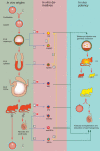The different shades of mammalian pluripotent stem cells
- PMID: 20705693
- PMCID: PMC3039219
- DOI: 10.1093/humupd/dmq035
The different shades of mammalian pluripotent stem cells
Abstract
Background: Pluripotent stem cells have been derived from a variety of sources such as from the inner cell mass of preimplantation embryos, from primordial germ cells, from teratocarcinomas and from male germ cells. The recent development of induced pluripotent stem cells demonstrates that somatic cells can be reprogrammed to a pluripotent state in vitro.
Methods: This review summarizes our current understanding of the origins of mouse and human pluripotent cells. We pay specific attention to transcriptional and epigenetic regulation in pluripotent cells and germ cells. Furthermore, we discuss developmental aspects in the germline that seem to be of importance for the transition of germ cells towards pluripotency. This review is based on literature from the Pubmed database, using Boolean search statements with relevant keywords on the subject.
Results: There are distinct molecular mechanisms involved in the generation and maintenance of the various pluripotent cell types. Furthermore, there are important similarities and differences between the different categories of pluripotent cells in terms of phenotype and epigenetic modifications. Pluripotent cell lines from various origins differ in growth characteristics, developmental potential, transcriptional activity and epigenetic regulation. Upon derivation, pluripotent stem cells generally acquire new properties, but they often also retain a 'footprint' of their tissue of origin.
Conclusions: In order to further our knowledge of the mechanisms underlying self-renewal and pluripotency, a thorough comparison between different pluripotent stem cell types is required. This will progress the use of stem cells in basic biology, drug discovery and future clinical applications.
Figures






Similar articles
-
Epigenetic foundations of pluripotent stem cells that recapitulate in vivo pluripotency.Lab Invest. 2017 Oct;97(10):1133-1141. doi: 10.1038/labinvest.2017.87. Epub 2017 Sep 4. Lab Invest. 2017. PMID: 28869587 Review.
-
The post-inner cell mass intermediate: implications for stem cell biology and assisted reproductive technology.Hum Reprod Update. 2015 Sep-Oct;21(5):616-26. doi: 10.1093/humupd/dmv028. Epub 2015 Jun 18. Hum Reprod Update. 2015. PMID: 26089403 Review.
-
Epigenetic reprogramming of the germ cell nuclear factor gene is required for proper differentiation of induced pluripotent cells.Stem Cells. 2013 Dec;31(12):2659-66. doi: 10.1002/stem.1367. Stem Cells. 2013. PMID: 23495137 Free PMC article.
-
Parallel gateways to pluripotency: open chromatin in stem cells and development.Curr Opin Genet Dev. 2010 Oct;20(5):492-9. doi: 10.1016/j.gde.2010.06.002. Epub 2010 Jul 2. Curr Opin Genet Dev. 2010. PMID: 20598875 Free PMC article. Review.
-
The use of signalling pathway inhibitors and chromatin modifiers for enhancing pluripotency.Theriogenology. 2010 Sep 1;74(4):525-33. doi: 10.1016/j.theriogenology.2010.05.030. Epub 2010 Jul 7. Theriogenology. 2010. PMID: 20615537 Review.
Cited by
-
The roles of FGF and MAP kinase signaling in the segregation of the epiblast and hypoblast cell lineages in bovine and human embryos.Development. 2012 Mar;139(5):871-82. doi: 10.1242/dev.071688. Epub 2012 Jan 25. Development. 2012. PMID: 22278923 Free PMC article.
-
The Mechanisms of Lithium Action: The Old and New Findings.Pharmaceuticals (Basel). 2025 Mar 26;18(4):467. doi: 10.3390/ph18040467. Pharmaceuticals (Basel). 2025. PMID: 40283904 Free PMC article. Review.
-
Common Marmoset Cell Lines and Their Applications in Biomedical Research.Cells. 2023 Aug 8;12(16):2020. doi: 10.3390/cells12162020. Cells. 2023. PMID: 37626830 Free PMC article. Review.
-
Identification of differentially expressed mRNAs and miRNAs in spermatozoa of bulls of varying fertility.Front Vet Sci. 2022 Oct 5;9:993561. doi: 10.3389/fvets.2022.993561. eCollection 2022. Front Vet Sci. 2022. PMID: 36277068 Free PMC article.
-
Suspension culture of human pluripotent stem cells in controlled, stirred bioreactors.Tissue Eng Part C Methods. 2012 Oct;18(10):772-84. doi: 10.1089/ten.TEC.2011.0717. Epub 2012 Jun 4. Tissue Eng Part C Methods. 2012. PMID: 22519745 Free PMC article.
References
-
- Andrews PW. Retinoic acid induces neuronal differentiation of a cloned human embryonal carcinoma cell line in vitro. Dev Biol. 1984;103:285–293. doi:10.1016/0012-1606(84)90316-6. - DOI - PubMed
-
- Andrews PW. Human teratocarcinomas. Biochim Biophys Acta. 1988;948:17–36. - PubMed
-
- Andrews PW, Damjanov I, Simon D, Banting GS, Carlin C, Dracopoli NC, Fogh J. Pluripotent embryonal carcinoma clones derived from the human teratocarcinoma cell line Tera-2. Differentiation in vivo and in vitro. Lab Invest. 1984;50:147–162. - PubMed
-
- Arman E, Haffner-Krausz R, Chen Y, Heath JK, Lonai P. Targeted disruption of fibroblast growth factor (FGF) receptor 2 suggests a role for FGF signaling in pregastrulation mammalian development. Proc Natl Acad Sci USA. 1998;95:5082–5087. doi:10.1073/pnas.95.9.5082. - DOI - PMC - PubMed

